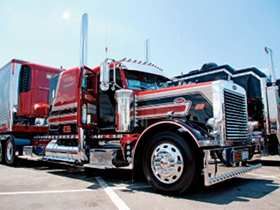Coolant Level (Need Answers ASAP)
Topic 17532 | Page 1
It should be safe to open the coolant resivoir. DO NOT remove the Radiator cap. I don't think the coolant level being at the minimum line would cause overheating. If there is coolant in the big clear tank, the system should be full. You may have a different problem.

Unless your coolant temp is running hot or your getting warning lights flashing on dash i wouldn't worry about if if it's just below minimum. If i were you i would go unload, shut the engine off while they are unloading you then after 3+hours after they are done then add coolant to a cold engine.
I would not recommend opening up the coolant on a hot or. Warm engine. Your coolant system might be pressurized and it could spray all over and you could really get hurt.

Unless your coolant temp is running hot or your getting warning lights flashing on dash i wouldn't worry about if if it's just below minimum. If i were you i would go unload, shut the engine off while they are unloading you then after 3+hours after they are done then add coolant to a cold engine.
I would not recommend opening up the coolant on a hot or. Warm engine. Your coolant system might be pressurized and it could spray all over and you could really get hurt.
My dash is flashing stop coolant extremely low but the coolant is just below minimum
I don't actually know the answer, so take my advice at your own risk :). But if it was me, I would figure that an hour was enough for it to be safe, but I'd still need to be cautious. I would take a rag or something and use it over the cap and unscrew it slowly, so that if coolant starts spraying out it wouldn't go all over me. Hopefully the cap would unscrew to the point where any pressure would release without the cap flying off, but I don't know. I don't even know if the reservoir ever has a lot of pressure in it.
Do you look at the level every day? Did it get low suddenly? If so, you might just end up with it low again in a short time. But I just had a leaky hose where the level went down slowly over days, so adding some might fix it for a while.
HOS:
Hours Of Service
HOS refers to the logbook hours of service regulations.
Removing the Serge tank cap the clear one slowly with a rag over it, will allow the presser to drop slowly, and you can add coolent anytime that way. The tank should only be at max of 15 psi. (This only works when low on coolent do not try with a full tank.)

Others have already replied, but there is one thing that has not been mentioned.
If the reservoir is empty, or very nearly empty, and you fill the clear reservoir while the engine is hot, as the water cools, it will draw fluid out of the reservoir into the engine, so filling the reservoir to the 'hot full' line may be the only thing you have to do, though checking the reservoir after the engine heats and cools again would be a smart idea.
If you fill an empty reservoir when the engine is cold, you need to check it again after the engine gets up to temperature, and cools again, because it will suck some fluid out of the reservoir. If the engine is cold enough to touch with bare hands, then you can fill the radiator and the reservoir if you want, but I typically avoid fooling with the radiator on any vehicle, if I can.
Surge tank (clear reservoir) is not pressurized. It catches the "overflow" via the pressure cap - and when the system is cool, it "draws in" coolant from the overflow, back into the radiator/cooling system.
So you can add coolant (50/50 mix - NEVER STRAIGHT WATER OR COOLANT - most coolant nowadays, comes PRE-MIXED so you don't have to worry - look for PRE-MIXED on the bottle).
Your overflow tank should have a COLD and HOT level marking on it.
NEVER NEVER NEVER open a HOT RADIATOR CAP - even with a RAG, even if someone else told you to. You have NO IDEA of the condition of the gasket on the cap - and it could spray you with BOILING COOLANT as soon as you move it to the first click (which is the "pressure relief position). Wait until the temp gauge reads as low as the temp of the coolant you wouldn't mind being sprayed with.
Let the engine sit and cool - remove the radiator cap and top off the radiator, then fill the overflow bottle to the COLD mark.
I'd start looking for LEAKS. Remember your PTI - hoses, clamps, check the water pump, etc. Abrasions/Bulges/Cuts - Securely Attached at both ends. Look for dried crystals, usually white or the color of your coolant around hoses, connections, the radiator, etc. Look for puddles after you've been sitting awhile.
And I wouldn't operate the truck - until you get the coolant back to normal levels and get the lamp to shut off (or determine that the coolant IS at normal levels and the sensor that drives the lamp is faulty).
Rick
HOS:
Hours Of Service
HOS refers to the logbook hours of service regulations.
I just wanted to say that on the Volvo's, freightliner, and internationals I have driven the only way to add coolent to them for a driver is thought the surge tank, and it is presserised on those trucks when you take the cap off when hot you can here it hiss and watch the coolent level rise, sometimes you can even watch the tank contract as the pressure is released. And Rick is right never add strate water, or limon water. You could but distilled water in there but then you would need to put equel strait antifreeze in, if you could even find it. Also to add to what Rick said about looking for external leeks check that cap on the surge tank, you should be able to turn it tell it clicks just like the gas cap on your car.
HOS:
Hours Of Service
HOS refers to the logbook hours of service regulations.
NEVER NEVER NEVER open a HOT RADIATOR CAP - even with a RAG, even if someone else told you to. ...
I was talking about the surge tank when I said that above, but maybe it wasn't clear. As far as I know there's no reason to add coolant to the radiator unless maybe the system was empty to start with.
New Reply:
New! Check out our help videos for a better understanding of our forum features

















Preview:








 TT On Facebook
TT On Facebook
I have a Volvo 780 my coolant level is just below minimum but my engine is hot is it safe to put some In I've been sitting a hour now have to deliver a load